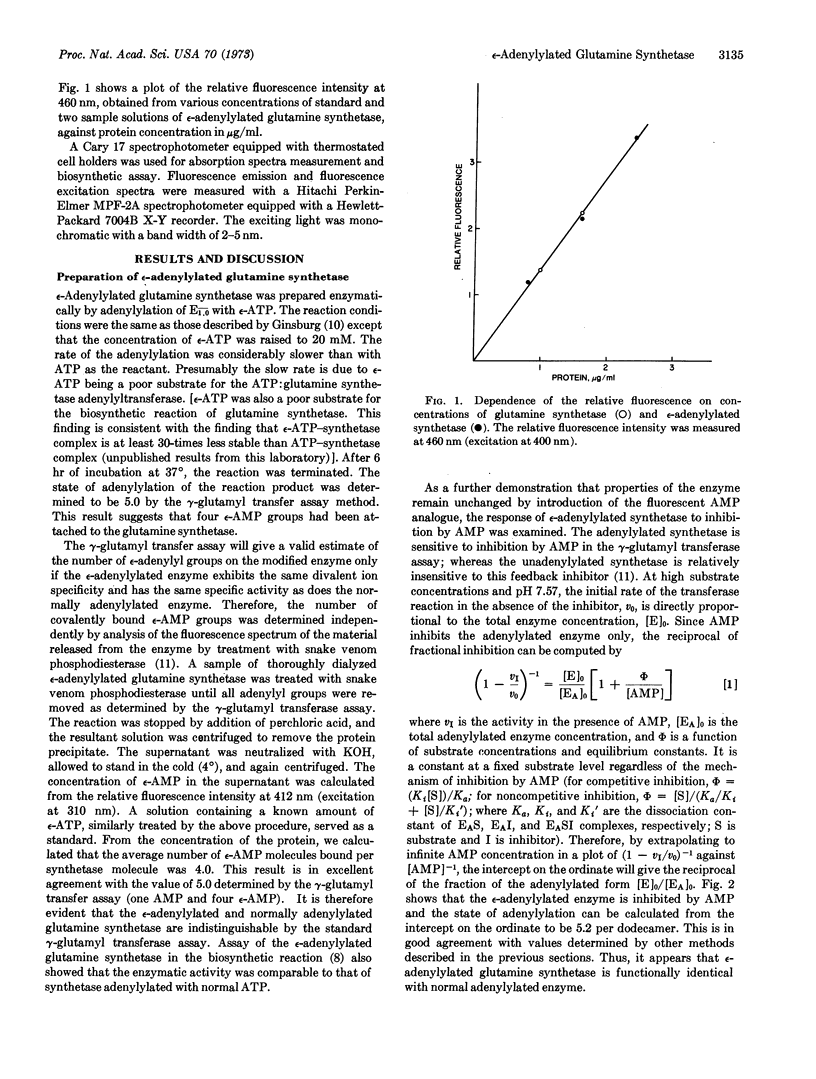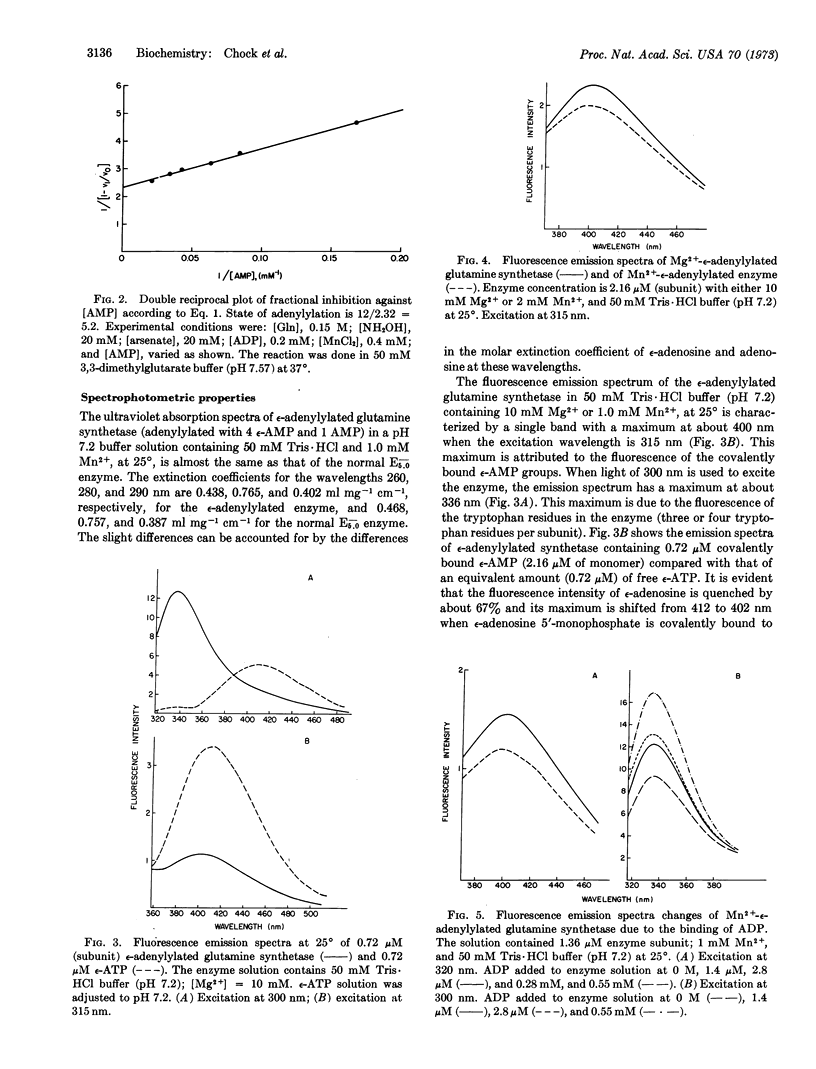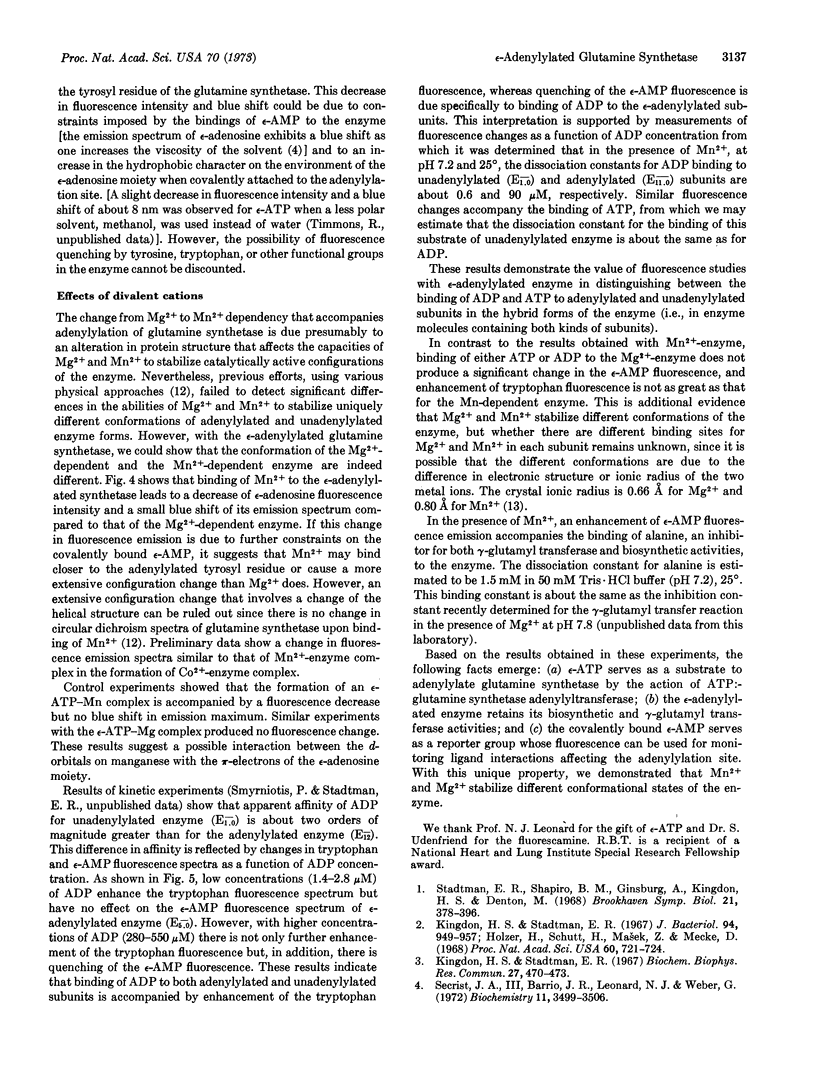Abstract
A fluorescent derivative of ATP, ε-ATP, was used to adenylylate glutamine synthetase (EC 6.3.1.2) from Escherichia coli enzymatically. The ε-adenylylated enzyme exhibits similar catalytic properties and inhibitor susceptibility to those of the naturally adenylylated enzyme. The fluorescence properties of the ε-adenosine and of tryptophan residues of the enzyme were used to study ligand-induced conformational changes involving alterations of the tryptophan regions and the adenylylation site of the protein. Binding of Mn2+ to the ε-adenylylated enzyme is accompanied by a decrease of ε-adenosine fluorescence as compared to the effect observed for the Mg2+ binding. An ADP binding study shows that at low ADP concentration, ADP causes enhancement of the tryptophan fluorescence only, reflecting the binding to unadenylylated subunits; and at high ADP concentration, ADP causes not only enhancement of the fluorescence, but also a quenching of the fluorescence of enzyme-bound ε-AMP, reflecting binding to the adenylylated subunits. Dissociation constants calculated from these fluorescence changes agree well with those determined from binding studies of ADP to adenylylated and unadenylylated enzymes. Binding of the feedback inhibitor, alanine, to Mn2+-dependent glutamine synthetase causes enhancement of the ε-AMP fluorescence, from which a dissociation constant of 1.5 mM was calculated for the inhibitor. The fluorescence changes observed due to ligands binding suggest that Mg2+ and Mn2+ stabilize different conformational states of the enzyme.
Keywords: ε-ATP, ligand-induced conformational changes
Full text
PDF




Selected References
These references are in PubMed. This may not be the complete list of references from this article.
- Anderson W. B., Stadtman E. R. Purification and functional roles of the P I and P II components of Escherichia coli glutamine synthetase deadenylylation system. Arch Biochem Biophys. 1971 Apr;143(2):428–443. doi: 10.1016/0003-9861(71)90229-3. [DOI] [PubMed] [Google Scholar]
- Ginsburg A., Yeh J., Hennig S. B., Denton M. D. Some effects of adenylylation on the biosynthetic properties of the glutamine synthetase from Escherichia coli. Biochemistry. 1970 Feb 3;9(3):633–649. doi: 10.1021/bi00805a025. [DOI] [PubMed] [Google Scholar]
- Hunt J. B., Ginsburg A. Some kinetics of the interaction of divalent cations with glutamine synthetase from Escherichia coli. Metal ion induced conformational changes. Biochemistry. 1972 Sep 26;11(20):3723–3735. doi: 10.1021/bi00770a010. [DOI] [PubMed] [Google Scholar]
- Kingdon H. S., Stadtman E. R. Regulation of glutamine synthetase. X. Effect of growth conditions on the susceptibility of Escherichia coli glutamine synthetase to feedback inhibition. J Bacteriol. 1967 Oct;94(4):949–957. doi: 10.1128/jb.94.4.949-957.1967. [DOI] [PMC free article] [PubMed] [Google Scholar]
- Kingdon H. S., Stadtman E. R. Two E. coli glutamine synthetases with different sensitivities to feedback effectors. Biochem Biophys Res Commun. 1967 May 25;27(4):470–473. doi: 10.1016/s0006-291x(67)80008-1. [DOI] [PubMed] [Google Scholar]
- Shapiro B. M., Kingdon H. S., Stadtman E. R. Regulation of glutamine synthetase. VII. Adenylyl glutamine synthetase: a new form of the enzyme with altered regulatory and kinetic properties. Proc Natl Acad Sci U S A. 1967 Aug;58(2):642–649. doi: 10.1073/pnas.58.2.642. [DOI] [PMC free article] [PubMed] [Google Scholar]
- Stadtman E. R., Shapiro B. M., Ginsburg A., Kingdon H. S., Denton M. D. Regulation of glutamine synthetase activity in Escherichia coli. Brookhaven Symp Biol. 1968 Jun;21(2):378–396. [PubMed] [Google Scholar]
- Udenfriend S., Stein S., Böhlen P., Dairman W., Leimgruber W., Weigele M. Fluorescamine: a reagent for assay of amino acids, peptides, proteins, and primary amines in the picomole range. Science. 1972 Nov 24;178(4063):871–872. doi: 10.1126/science.178.4063.871. [DOI] [PubMed] [Google Scholar]
- Woolfolk C. A., Shapiro B., Stadtman E. R. Regulation of glutamine synthetase. I. Purification and properties of glutamine synthetase from Escherichia coli. Arch Biochem Biophys. 1966 Sep 26;116(1):177–192. doi: 10.1016/0003-9861(66)90026-9. [DOI] [PubMed] [Google Scholar]


